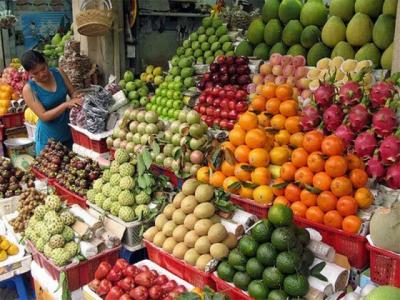Vietnamese prefer Thai and Chinese fruit & vegetables

Vietnamese people spent more than $164 million on fruit and vegetable imports in the first two months of 2017, of which 70 per cent were from Thailand and China, according to figures from the General Department of Customs (GDC).
Import value fell nearly 31 per cent year-on-year. On average, Vietnamese people spend nearly $2.8 million per day on imported fruit and vegetables.
Thailand and China’s 70 per cent market share was equal to $114.2 million.
Thailand is the largest source, with turnover of $82.6 million, or 50 per cent. China saw turnover reach $31.6 million.
Myanmar and the US followed, with $15 million and $13.2 million, respectively.
Most imports were mangos, custard-apples, and tamarind from Thailand and apples, oranges, pears, kiwi fruit, and cherries from New Zealand and Australia, while those from China were mainly cabbage, lettuce, potatoes, oranges, and apples.
According to agricultural experts, the two main reasons why Vietnamese have been attracted to Thai fruit in recent years are the difference in taste and the quality.
Exports, meanwhile, were more than $421,000 in the first two months, up 27 per cent year-on-year.
Major markets were China, Japan, Taiwan, and Canada.
Có thể bạn quan tâm
 Vietnamese lychees shipped to more than 30 countries
Vietnamese lychees shipped to more than 30 countries Approximately 87,000 tonnes of Thieu lychees harvested in the lychee farming hub of Bac Giang province have been exported to 30 countries
 Vietnam agri firms seek cooperation opportunities in Switzerland
Vietnam agri firms seek cooperation opportunities in Switzerland A trade and investment promotion forum on agriculture in Zurich, Switzerland on June 29 helped businesses of the two countries find agricultural cooperation
 Large-scale fields yield higher profits for farmers in Ninh Thuận
Large-scale fields yield higher profits for farmers in Ninh Thuận Farmers in the south-central province of Ninh Thuận are planting more rice, corn, sugarcane and other crops on large-scale fields to raise incomes.
 Bac Giang earns 5.4 trillion VND from lychees
Bac Giang earns 5.4 trillion VND from lychees The northern province of Bac Giang has so far sold 191,000 tonnes of lychees for over 5.4 trillion VND (236.8 million USD)
 Hoang Anh Gia Lai bets on banana, Chinese market in agriculture switch
Hoang Anh Gia Lai bets on banana, Chinese market in agriculture switch Once a leading property developer, Hoang Anh Gia Lai has reinvented itself as a hi-tech agriculture giant.